
Muscle Energy Techniques – Soft Tissue Release
July 10, 2016
PLANTAR FASCIITIS / HEEL PAIN
July 27, 2016With High Intensity Interval Training (HIIT) becoming more popular among fitness enthusiast, the frequency of muscular injuries is higher than ever as a result of elevated stress tolerances when performing these trainings. Muscle Activation Techniques (MAT) was a technique created by Greg Roskopf to treat muscular dysfunctions, that are due to inefficient communication between the brain and muscles, as a result of injuries obtained after performing HIIT exercise. MAT takes a different approach on injury in that muscular tightness is secondary to muscular weakness and not the other way around. As such, how does MAT work?
Upon initial assessment, an MAT practitioner will assessment range of motion (ROM) within the patient to see if any differences are apparent between left and right sides of the body. This may be done passively in that the practitioner moves the patient’s limbs into the desired position or can be done actively by having the patient utilize their own musculature to position their limbs. Wherever a limitation in range of motion is perceived, indications that one or more muscles that cross that joint can’t contract efficiently. As a result, the muscles on the opposite side of the joint will tighten up as a protective mechanism to increase stability. That protective mechanism results in improper alignment of the spine, joints and tissues which will intern increase stress on certain structures until they eventually fail. A comparison can be made to a car with mal aligned steering; the longer and faster you drive the car with this steering, the more stress is placed on other structures until something cannot function anymore or let’s go. At this point, the practitioner can use two different techniques to re-activate and re-establish neural drive to the weaker muscles:
- Performing Digital Force application for Muscle Activation Techniques (DFAMAT)
- With the use of Positional Isoangular Contractions (PIC)
The DFAMAT technique is more effective in increasing overall neural drive to the muscle. An MAT therapist will use this technique by applying a small force to the origin and insertion sites of muscles in order to increase neural drive to the brain. The PIC technique is more time consuming in that one therapist must position the desired muscle under contraction and hold that contraction for an extended period of time to increase the neural response of the brain. This is done by having the individual place themselves or the desired limb in a specific position indicated by the practitioner in order to stress the muscle and stimulate a neural response by the brain. Both techniques are effective in restoring neural drive and will help to alleviate pain when biomechanical balance is re-established across the joint.
Compared with traditional therapy where soft tissue work is of prime importance, an MAT therapist will make sure that biomechanical efficiency, neural drive and joint stability is established before anything else. People of all age can benefit from MAT and is best felt when performed just before taking part in any kind of event that involves physical exertion.
Oliver.

